Electric water heaters for the shower: types, features,
What are the electric heaters for the shower offered by the modern market? Which of them should be preferred to the potential buyer, what advantages and disadvantages do different solutions have? Are there any features of their connection? Let's try to answer these questions.
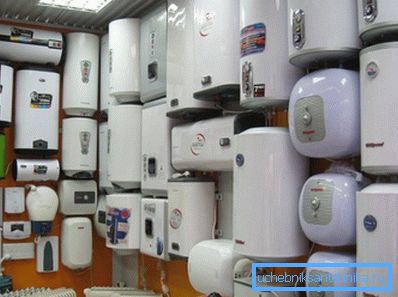
Classification
The devices of interest to us can be divided according to two main features:
- Flow and accumulative. As it is easy to guess, the first heat the water directly at its consumption; the latter create in the insulated container a supply of water heated to a predetermined temperature.
- Flow, in turn, are divided into pressure (installed in the pipeline rupture under pressure) and free-flow (those that are mounted after the valves and connect directly to the shower head).
Specify: the name free-flow is rather arbitrary. In a flow tank with a heating element, an overpressure of up to 3 kgf / cm can be created - simply due to the fact that the capacity of the inlet tap exceeds the water flow through the shower head.
Self-leveling electric water heaters for the shower in the country. They, in essence, are a conventional tank for a country shower with a tap and built-in heater. In the presence of centralized water supply, these devices are not used.
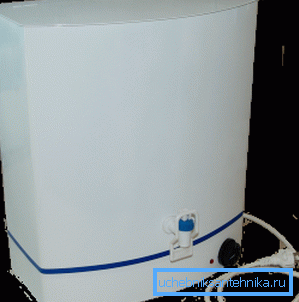
Device
Flow through
It is a miniature flow tank with an electric heating element and a copper heat exchanger. Power adjustment - speed; younger models may have a single mode of operation with a power of 3.5 kW. Water temperature is governed by the selection of water pressure.
Mandatory design element - pressure sensor. It does not allow to turn on the heat, while the pressure on the heat exchanger is less than 0.25 - 0.3 kgf / cm2; this prevents the device from overheating in the absence of water.

Accumulative
Its body is a heat-insulated tank made of stainless or enamelled black steel. Inside placed TEN; double wall heat insulation is made of polyurethane foam.
For heating to the desired temperature is usually responsible mechanical thermostat with a relay, breaking the power supply circuit of the heating element; A simple thermometer shows the current temperature level.
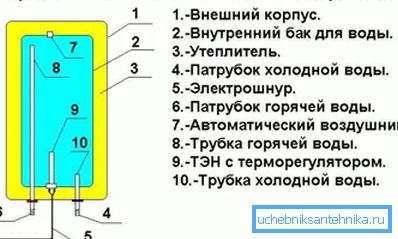
Comparison
Let's put together the positive and negative properties that a flowing electric water heater has for a shower and the competing solution - an electric boiler.
| Property | Flow heater | Boiler |
| Power consumption | 3.5 - 24 KW | 1.0 - 2.0 kW |
| Connection | 3.5 kW - socket, 5 - 7 kW - dedicated line from the panel with a supply voltage of 220 V, more than 7 kW - dedicated line from the panel with a voltage of 380 V. | Socket |
| Retail price | From 4000 rubles | From 800 rubles |
| Efficiency | Above. Electricity is consumed only for heating water. | Below. Heat is lost through the insulation of the tank around the clock. |
| Accuracy of maintenance of the set temperature | Low The water temperature at the outlet depends linearly on its inlet temperature. | High. Heating strictly to a predetermined temperature is provided by a thermostat. |
About the devices we are interested in it is useful to know a few more things.
- Younger models of flow heaters (3.5 - 5 kW) are useful only in summer, when the water inlet temperature is not lower than +15 - +20 C. In winter, it drops to +5 С; at a fixed power, the heater is able to heat it at a quite certain number of degrees from the initial value.
- Non-pressure heaters are equipped with watering cans with holes of very small diameter, which allow to create a good water pressure at its minimum consumption. Attempting to replace the watering can will lead to the fact that it is necessary to wash with cold water.
In addition: the increased size of the holes in the watering can means that it will be possible to obtain the required 0.3 kgf / cm2 for switching on the heater at a significantly higher flow rate. This again will affect the final water temperature.

- The 80-liter accumulative electric water heater on a shower is completely spent by one person in 10-15 minutes. The second family member is forced to wait at least half an hour to heat the next portion of water. Flow heaters are free from this problem.
Selection
If we provide the reader with the choice of a particular type of heater, they will be given a number of additional recommendations on the selection of other characteristics.
- The flow device with a capacity of 3.5 - 5 kW can serve only one point of water pumping, and then with certain restrictions.. For the full use of the shower and sink at the same time need at least 12 - 16 kW of electrical power.
- The boiler for the kitchen can have a volume of only 15-20 liters. This is quite enough to wash a serving of dishes for a small family. But the shower requires a minimum volume of 50 liters; a truly comfortable shower will be in the presence of a supply of warm water at least 80-100 liters.
- In-line (pressure) flow-through heater is convenient in that it can be taken out of the shower or beyond the bath. Non-pressure device will have to be powered by hiding the wiring in the grooves. About installing in the shower sockets, you know, we are not talking in principle.
Installation
Is it difficult to install any of the above mentioned devices with your own hands?
General rules
- Grounding is required. If it is not divorced in the apartment - throw the cable from the shield.

Attention: it is impossible to ground the socket on a steel water supply system. This will drastically accelerate the corrosion of pipes, and in case of insulation breakdown in the body of the device, this grounding method will turn your shower into a very effective type of electric chair.
- Wiring - only copper. When calculating its cross section, a simple instruction is valid: 1 mm2 cross section corresponds to 8 A of current. It is easy to calculate the current by dividing the rated power of the device by the supply voltage.
Flow-through pressure
There are no subtleties here: the device is installed in the water line break and it is joined by two American women, who will quickly remove it for repair. When servicing several points of water pumping, the heater is, if possible, placed at the same distance from each of them.

Flow-free non-pressure
If the device is used seasonally, at the time of summer shutdowns of hot water supply, it is connected to a stationary mixer with a shower hose. The inlet has the same thread as a shower. Accordingly, the control of water pressure is carried out by taps or a mixer lever.
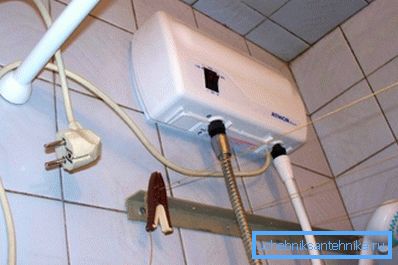
With a fixed installation in front of the device is installed any valve through passage. The electric water heater for the shower is connected to it with a conventional flexible connector.
Curiously: the author used to connect a 3.5-kilowatt Atmora on-board water outlet valve mounted on an acrylic bath shelf. Instead of a spout, a 3/4 - 1/2 inch adapter was installed, which, again, was connected to the instrument's entrance with a hose with cap nuts.
Boilers
And these devices are mounted in the rupture of the DHW pipeline.
Here it is useful to know a few nuances.
- Installation is carried out only hard liner.
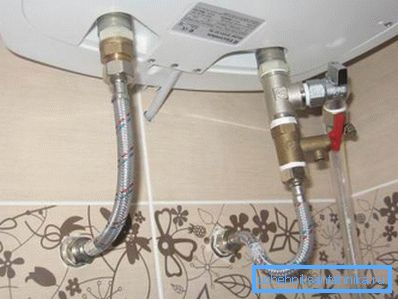
- Buck hangs exclusively on the main wall. Filled with water, it can weigh more centners.
- Before the boiler, a safety valve of 6 kgf / cm is required. With a high probability of water hammer, it is useful to supplement it with a pressure reducer.
- It is worthwhile to add a check valve to the assembly, which will not allow hot water to go to the cold water supply when the cold supply is turned off.
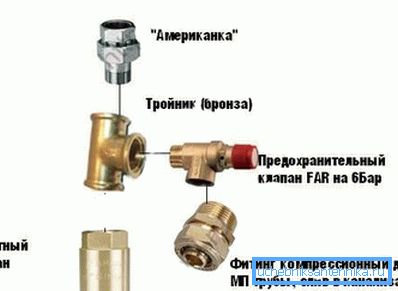
Conclusion
We hope that our simple recommendations will help the reader to solve their everyday problems - after all, they arise in all and always. As usual, the video in this article will offer additional information. Successes!